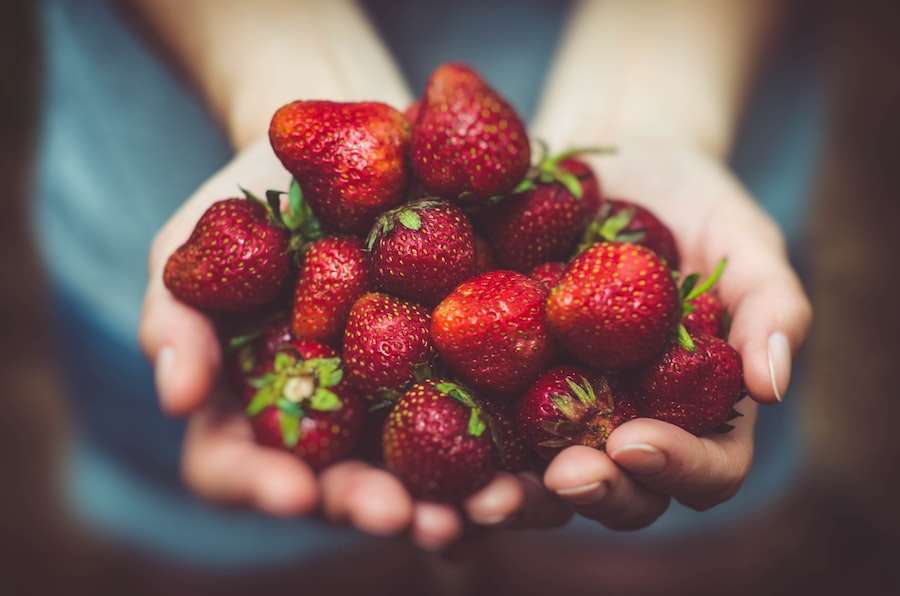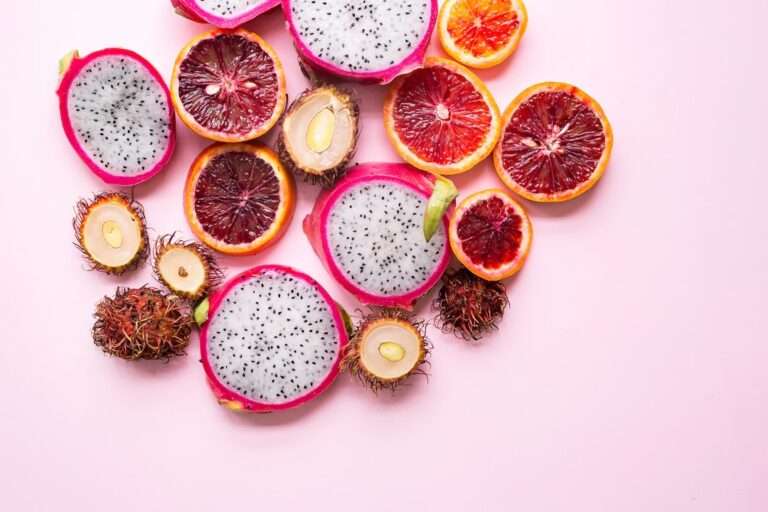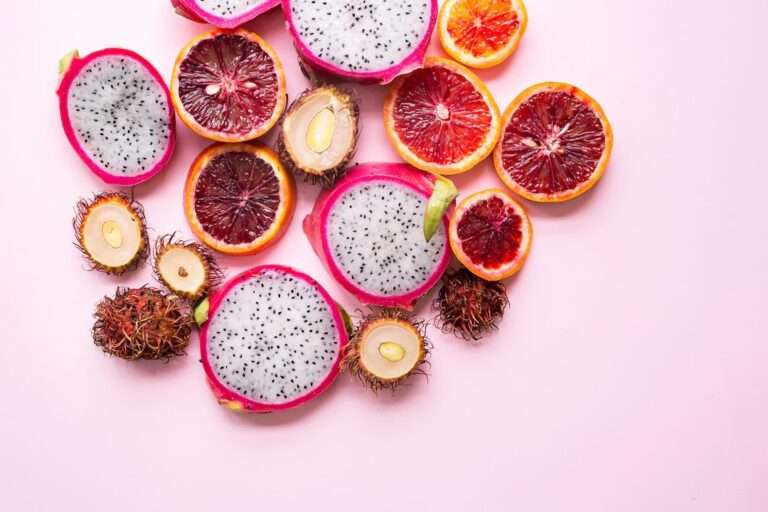Color Symbolism in Food and Cuisine

Color plays a crucial role in our perception of food and cuisine. It has the power to enhance or detract from the flavor of a dish, evoke cultural significance, and even impact our health. From the vibrant red of a ripe tomato to the deep green of fresh spinach, color not only adds visual appeal to our meals but also provides important cues about taste and nutrition. In this article, we will explore the psychology, cultural significance, science, symbolism, marketing, and culinary aspects of color in food.
The Psychology of Color: How It Affects Our Perception of Taste
Color has a profound impact on our perception of taste. Research has shown that our brains are wired to associate certain colors with specific flavors. For example, we tend to associate red with sweetness and yellow with sourness. This is why many fruits that are high in sugar content, such as strawberries and oranges, are often red or orange in color.
In addition to influencing our perception of taste, color can also enhance or detract from the flavor of a dish. For example, studies have shown that people perceive food to be sweeter when it is served on a white plate compared to a black plate. Similarly, the color of a drink can influence our perception of its flavor. A study conducted at the University of Oxford found that participants rated a strawberry-flavored milkshake as being more intense and strawberry-like when it was pink in color compared to when it was white.
The Cultural Significance of Color in Food: A Global Perspective
Color plays a significant role in different cultures’ cuisines. In many Asian cultures, for example, red is considered an auspicious color and is often used in celebratory dishes. In Chinese cuisine, red is associated with good luck and prosperity, which is why dishes like Peking duck and red bean soup are popular during festive occasions. In Indian cuisine, yellow is often used to represent purity and fertility, which is why turmeric, a yellow spice, is commonly used in dishes like curry.
Similarly, color is used to represent cultural values and traditions. In Mexican cuisine, for example, the colors of the flag (green, white, and red) are often incorporated into dishes to symbolize national pride. The use of green chilies, white onions, and red tomatoes in dishes like salsa verde and pico de gallo not only adds flavor but also represents the Mexican identity.
The Science Behind Color: How It Impacts Nutrition and Health
Color can also provide important clues about the nutritional value of a food. Different colors in fruits and vegetables are often indicative of the presence of specific nutrients. For example, orange fruits and vegetables like carrots and sweet potatoes are rich in beta-carotene, which is converted into vitamin A in the body. Green leafy vegetables like spinach and kale are high in chlorophyll, which is a good source of vitamins A, C, and K.
In addition to providing essential nutrients, different colors of food can also benefit our health in various ways. For example, red fruits like strawberries and watermelon contain antioxidants called anthocyanins, which have been shown to reduce the risk of heart disease and certain types of cancer. Blue and purple fruits like blueberries and grapes are rich in antioxidants called anthocyanins, which have been linked to improved brain function and reduced inflammation.
The Symbolism of Color in Food: From Ancient Times to Modern Day
Color has played a significant role in food symbolism throughout history. In ancient times, certain colors were associated with specific meanings. For example, in ancient Egypt, yellow was associated with gold and was considered a symbol of immortality. This is why honey was often used as an offering to the gods.
In modern times, color symbolism in food has evolved to reflect cultural and societal values. For example, the color green is often associated with health and sustainability. This is why many organic and plant-based food products use green packaging to convey a sense of naturalness and environmental consciousness.
The Role of Color in Food Marketing and Advertising

Color is a powerful tool in food marketing and advertising. It can be used to attract consumers to food products and influence their purchasing decisions. Research has shown that certain colors can evoke specific emotions and behaviors. For example, red is often associated with excitement and passion, which is why it is commonly used in fast-food logos and advertisements.
In addition to evoking emotions, color can also influence our perception of taste and quality. Studies have shown that people perceive food to be more flavorful and of higher quality when it is presented in vibrant colors. This is why many food companies use bright and bold colors in their packaging and advertisements to make their products more appealing to consumers.
Colorful Ingredients: Exploring the Benefits and Uses of Natural Food Coloring
Natural food coloring is becoming increasingly popular as consumers seek healthier alternatives to artificial additives. Natural food coloring options include fruits, vegetables, spices, and herbs that can be used to add vibrant colors to dishes without compromising on taste or health benefits.
One of the benefits of using natural food coloring is that it allows for greater creativity in the kitchen. Chefs can experiment with different ingredients to create unique and visually appealing dishes. For example, beetroot can be used to create a vibrant pink color, while turmeric can be used to create a rich yellow color.
In addition to adding color, natural food coloring also provides additional health benefits. Many fruits and vegetables that are used as natural food coloring options are rich in antioxidants, vitamins, and minerals. For example, blueberries, which can be used to create a deep blue color, are packed with antioxidants that help protect against oxidative stress and inflammation.
Color Pairings in Cuisine: How Chefs Use Color to Create Flavor and Aesthetics
Chefs use color pairings to enhance the flavor and aesthetics of a dish. Certain color combinations can create a harmonious balance of flavors, while others can create a striking visual impact. For example, the combination of red and green in dishes like caprese salad (tomato and mozzarella) creates a visually appealing contrast that is also reflected in the flavors.
Different cuisines have their own unique color pairings that are used to create specific flavor profiles. In Italian cuisine, for example, the combination of red (tomato) and white (mozzarella) is commonly used to create a fresh and vibrant flavor. In Thai cuisine, the combination of green (basil) and red (chili) is used to create a spicy and aromatic flavor.
The Impact of Color on Food Presentation and Plating
Color plays a crucial role in the presentation and plating of a dish. It can make a dish look more appetizing and visually appealing, which can enhance the dining experience for consumers. Chefs often use color to create contrast, balance, and visual interest on the plate.
For example, a dish that is predominantly brown in color can be made more visually appealing by adding pops of vibrant colors like green herbs or red tomatoes. Similarly, a dish that is predominantly white in color can be made more visually interesting by adding colorful garnishes like edible flowers or citrus zest.
Color can also be used to create a sense of harmony and balance on the plate. For example, a dish that is predominantly red in color can be balanced out by adding complementary colors like green or yellow. This not only adds visual appeal but also enhances the overall flavor profile of the dish.
The Importance of Color in Enhancing the Dining Experience
In conclusion, color plays a vital role in food and cuisine. It affects our perception of taste, represents cultural values and traditions, provides important nutritional cues, symbolizes different meanings, influences consumer behavior, enhances creativity in the kitchen, creates flavor and aesthetic pairings, and impacts the presentation and plating of a dish. Understanding the role of color in food can help us appreciate the artistry and science behind culinary creations and enhance our overall dining experience. So next time you sit down for a meal, take a moment to appreciate the colors on your plate and how they contribute to your enjoyment of the food.
If you’re fascinated by the symbolism of color in food and cuisine, you might also be interested in exploring the symbolism of the star. Stars have long been associated with various meanings and interpretations across different cultures and religions. From representing guidance and inspiration to symbolizing hope and spirituality, the star holds a significant place in our collective consciousness. To delve deeper into the symbolism of the star, check out this intriguing article on Symbolism Hub: Symbolism of the Star.
FAQs
What is color symbolism in food and cuisine?
Color symbolism in food and cuisine refers to the use of colors in food to convey certain meanings or emotions. Different colors are associated with different emotions, and chefs and food manufacturers use this knowledge to create visually appealing and emotionally stimulating dishes.
What are some common color associations in food?
Red is often associated with passion, energy, and excitement, while yellow is associated with happiness, warmth, and friendliness. Green is associated with health, nature, and freshness, while blue is associated with calmness and serenity. Orange is associated with enthusiasm and creativity, while purple is associated with luxury and sophistication.
How do chefs use color symbolism in their dishes?
Chefs use color symbolism in their dishes by carefully selecting ingredients that will create the desired color palette. They may also use food coloring or natural dyes to enhance or alter the colors of certain ingredients. Additionally, chefs may use plating techniques to create visually appealing and emotionally stimulating presentations.
What are some examples of color symbolism in food?
Examples of color symbolism in food include using red ingredients like tomatoes and peppers to create a spicy dish that conveys passion and energy, or using green ingredients like leafy greens and herbs to create a fresh and healthy dish that conveys nature and vitality. Chefs may also use blue ingredients like blueberries or purple ingredients like eggplant to create dishes that convey calmness and sophistication.
How does color symbolism vary across cultures?
Color symbolism can vary widely across cultures, with different colors having different meanings and associations in different parts of the world. For example, in Western cultures, white is often associated with purity and innocence, while in some Asian cultures, white is associated with death and mourning. Similarly, red is often associated with luck and prosperity in Chinese culture, while in Western cultures, it is associated with passion and excitement.





